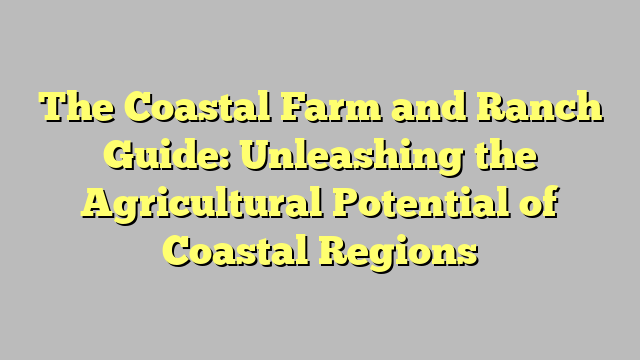
The Coastal Farm and Ranch Guide: Unleashing the Agricultural Potential of Coastal Regions
The coastal regions hold untapped potential for agricultural development, offering a unique blend of natural resources and fertile landscapes. Coastal farms and ranches have the advantage of proximity to the sea, enabling access to rich marine life and water sources that can support diverse agricultural activities. From cultivating a variety of crops to raising livestock, the coastal environment presents exciting possibilities for farmers and ranchers to harness the bounty of the land and sea. In this guide, we will explore the agricultural prospects of coastal farm and ranch operations, uncovering the opportunities and challenges that come with utilizing these extraordinary regions. Join us as we dive into the world of coastal farming and ranching and discover ways to unleash its full potential.
Advantages of Coastal Farming and Ranching
Coastal farming and ranching offer unique advantages that make them appealing to agricultural enthusiasts. The proximity to the coast provides a range of benefits for these ventures, allowing farmers and ranchers to tap into the abundant resources and favorable climatic conditions. Let’s explore some of the advantages that make coastal farming and ranching a promising choice.
Access to Marine Resources: One of the significant advantages of coastal farming and ranching is the access to a diverse array of marine resources. Coastal regions often offer abundant fishing grounds, providing an additional source of income for farmers and ranchers. The availability of fresh seafood and seaweed offers opportunities for diversification and supplementing crop and livestock production.
Favorable Climate: Coastal areas often benefit from a maritime climate, which can be advantageous for agricultural activities. The proximity to large water bodies can moderate temperature extremes, resulting in milder winters and cooler summers. This favorable climate promotes the growth of a variety of crops and supports the health and productivity of livestock.
Variety of Crops and Grazing Options: Coastal environments are well-suited for a wide range of crops and grazing options. The combination of fertile soils, adequate rainfall, and temperate climate allows for the cultivation of crops such as fruits, vegetables, grains, and even specialty crops like vineyards. Additionally, the coastal grasslands and marshes provide ample grazing opportunities for livestock, ensuring a diversified and sustainable farming and ranching operation.
Coastal farming and ranching present exciting prospects for agricultural enthusiasts. The access to marine resources, favorable climate, and the variety of crop and grazing options make coastal regions a prime location for successful farm and ranch ventures. Embracing the agricultural potential of these coastal areas can lead to economic growth and contribute to the overall sustainability of the agricultural industry.
Challenges Faced by Coastal Farmers and Ranchers
coastal farm and ranch locations
Coastal farmers and ranchers encounter several unique challenges while trying to maximize the agricultural potential of coastal regions. These challenges are often dictated by the geographical factors and specific environmental conditions that characterize these areas.
Firstly, one of the major hurdles faced by coastal farmers and ranchers is the continuous battle against saltwater intrusion. With the proximity to the ocean, coastal areas are prone to high levels of salt content in the soil and water, which can be detrimental to crop growth and livestock health. Managing and mitigating the effects of saltwater intrusion require advanced techniques and continual monitoring, adding an extra layer of complexity to the farming and ranching practices.
Secondly, coastal regions are subject to harsh weather conditions, including strong winds, heavy rainfalls, and tropical storms. These extreme weather events pose a significant risk to the stability and productivity of coastal farms and ranches. Structures such as barns, fences, and greenhouses need to be built to withstand the force of gusty winds, and appropriate drainage systems must be in place to prevent flooding during heavy rainfall. Additionally, the vulnerability to tropical storms requires quick response and preparation to safeguard the livestock, crops, and property.
Lastly, coastal farmers and ranchers often face limited access to freshwater resources. While water is essential for irrigation, livestock hydration, and general farm operations, the availability of freshwater can be restricted in coastal areas due to factors such as high salinity levels or limited groundwater resources. This scarcity of freshwater requires efficient water management practices, including the use of alternative water sources such as rainwater harvesting and desalination techniques.
In conclusion, coastal farmers and ranchers grapple with distinct challenges that arise from their geographical location. Saltwater intrusion, extreme weather events, and limited freshwater access all impact the agricultural productivity and sustainability of coastal farms and ranches. Overcoming these challenges requires practical solutions, innovative techniques, and a deep understanding of the unique dynamics of coastal agriculture.
Strategies for Maximizing Agricultural Potential in Coastal Regions
Utilize Salt-Tolerant Crops: One of the key strategies for maximizing agricultural potential in coastal regions is the cultivation of salt-tolerant crops. These crops have the ability to withstand the high levels of salinity in coastal soils and still thrive. By selecting and planting these crops, farmers can make the most of their land and ensure a more sustainable agricultural system that is adapted to the coastal environment.
Implement Effective Drainage Systems: Coastal regions often face challenges related to high water tables and excessive moisture content in the soil. To overcome this, it is crucial for farmers to implement effective drainage systems. This can involve the installation of well-designed drainage ditches, contouring the land to promote proper runoff, and the use of underground drainage tiles. By managing water levels and preventing waterlogging, farmers can create a more favorable environment for their crops.
Embrace Precision Agriculture Techniques: Precision agriculture techniques can play a vital role in maximizing agricultural potential in coastal regions. By utilizing technologies such as GPS, remote sensing, and data analytics, farmers can obtain accurate information about soil conditions, moisture levels, and crop health. This knowledge can then be used to make informed decisions regarding irrigation, fertilization, and pest control. By optimizing resource allocation and minimizing wastage, precision agriculture can greatly enhance productivity in coastal farming and ranching.
Remember, these strategies can help coastal farmers and ranchers unlock the full potential of their land and ensure a more sustainable and profitable agricultural enterprise. By embracing these approaches, farmers can not only overcome the unique challenges of coastal regions but also thrive in their agricultural pursuits.

